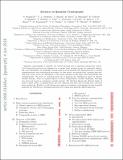Notice
This is not the latest version of this item. The latest version can be found at:https://dspace.mit.edu/handle/1721.1/129608.2
Advances in Quantum Cryptography
| dc.contributor.author | Pirandola, Stefano | |
| dc.contributor.author | Bunandar, Darius | |
| dc.contributor.author | Englund, Dirk R. | |
| dc.date.accessioned | 2021-02-01T18:24:10Z | |
| dc.date.available | 2021-02-01T18:24:10Z | |
| dc.date.submitted | 2019-06 | |
| dc.identifier.issn | 1943-8206 | |
| dc.identifier.uri | https://hdl.handle.net/1721.1/129608 | |
| dc.description.abstract | Quantum cryptography is arguably the fastest growing area in quantum information science.Novel theoretical protocols are designed on a regular basis, security proofs are constantly improv-ing, and experiments are gradually moving from proof-of-principle lab demonstrations to in-fieldimplementations and technological prototypes. In this review, we provide both a general introduc-tion and a state of the art description of the recent advancesin the field, both theoretically andexperimentally. We start by reviewing protocols of quantumkey distribution based on discretevariable systems. Next we consider aspects of device independence, satellite challenges, and highrate protocols based on continuous variable systems. We will then discuss the ultimate limits ofpoint-to-point private communications and how quantum repeaters and networks may overcomethese restrictions. Finally, we will discuss some aspects of quantum cryptography beyond standardquantum key distribution, including quantum data locking and quantum digital signatures. | en_US |
| dc.language.iso | en | |
| dc.publisher | The Optical Society | en_US |
| dc.relation.isversionof | 10.1364/AOP.361502 | en_US |
| dc.rights | Creative Commons Attribution-Noncommercial-Share Alike | en_US |
| dc.rights.uri | http://creativecommons.org/licenses/by-nc-sa/4.0/ | en_US |
| dc.source | arXiv | en_US |
| dc.title | Advances in Quantum Cryptography | en_US |
| dc.type | Article | en_US |
| dc.identifier.citation | Pirandola, S. et al. “Advances in Quantum Cryptography.” Advances in Optics and Photonics, 12, 4 (June 2019): 1012-1236 © 2019 The Author(s) | en_US |
| dc.contributor.department | Massachusetts Institute of Technology. Research Laboratory of Electronics | en_US |
| dc.relation.journal | Advances in Optics and Photonics | en_US |
| dc.eprint.version | Original manuscript | en_US |
| dc.type.uri | http://purl.org/eprint/type/JournalArticle | en_US |
| eprint.status | http://purl.org/eprint/status/NonPeerReviewed | en_US |
| dc.date.updated | 2020-12-14T18:25:54Z | |
| dspace.orderedauthors | Pirandola, S; Andersen, U; Banchi, L; Berta, M; Bunandar, D; Colbeck, R; Englund, D; Gehring, T; Lupo, C; Ottaviani, C; Pereira, J; Razavi, M; Shamsul Shaari, J; Tomamichel, M; Usenko, V; Vallone, G; Villoresi, P; Wallden, P | en_US |
| dspace.date.submission | 2020-12-14T18:26:02Z | |
| mit.journal.volume | 12 | en_US |
| mit.journal.issue | 4 | en_US |
| mit.license | OPEN_ACCESS_POLICY |
